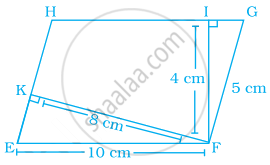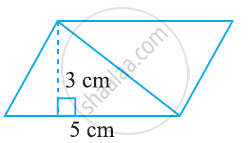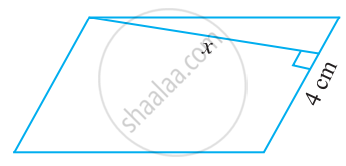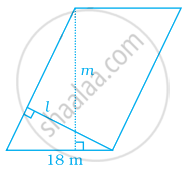Advertisements
Advertisements
Question
In the given figure, EFGH is a parallelogram, altitudes FK and FI are 8 cm and 4 cm respectively. If EF = 10 cm, then area of EFGH is ______.

Options
20 cm2
32 cm2
40 cm2
80 cm2
Solution
In the given figure, EFGH is a parallelogram, altitudes FK and FI are 8 cm and 4 cm respectively. If EF = 10 cm, then area of EFGH is `bb(underline(40 cm^2))`.
Explanation:

From the figure,
Consider the parallelogram EFGH,
EF = HG = 10 cm ......[From the question]
We know that, area of parallelogram EFGH = Base × Corresponding height
= 10 × 4
= 40 cm2
APPEARS IN
RELATED QUESTIONS
Find the area of the following parallelogram:

Find the area of the following parallelogram:

PQRS is a parallelogram (see the given figure). QM is the height from Q to SR and QN is the height from Q to PS. If SR = 12 cm and QM = 7.6 cm. Find:
- the area of the parallelogram PQRS
- QN, if PS = 8 cm

If base of a parallelogram is 18 cm and its height is 11 cm, find its area.
Find the height ‘x’ if the area of the parallelogram is 24 cm2 and the base is 4 cm.

If the sides of a parallelogram are increased to twice its original lengths, how much will the perimeter of the new parallelogram?
In the given figure, find the area of parallelogram ABCD, if the area of shaded triangle is 9 cm2.

Altitudes MN and MO of parallelogram MGHK are 8 cm and 4 cm long respectively in the below figure. One side GH is 6 cm long. Find the perimeter of MGHK.

Perimeter of a parallelogram shaped land is 96 m and its area is 270 square metres. If one of the sides of this parallelogram is 18 m, find the length of the other side. Also, find the lengths of altitudes l and m in the given figure.

ABCD is a parallelogram in which AE is perpendicular to CD as shown in the given figure. Also, AC = 5 cm, DE = 4 cm and area of ΔAED = 6 cm2. Find the perimeter and area of parallelogram ABCD.
